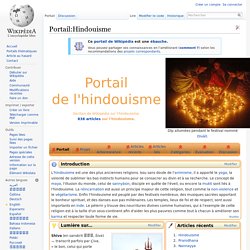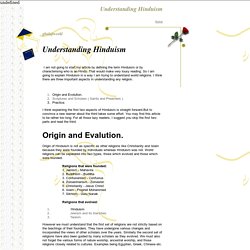

Portail:Hindouisme. Une page de Wikipédia, l'encyclopédie libre.

Portail de l'hindouisme Section de Wikipédia sur l'hindouisme.838 articles sur l'hindouisme. Dīp allumées pendant le festival nommé Divālī. Shiva (en sanskrit शिव, Śiva) — transcrit parfois par Çiva, « le bon, celui qui porte bonheur » — est un dieu hindou, un des membres de la Trimoûrti avec Brahmā et Vishnou, les deux autres aspects premiers du concept hindou de divinité. Shiva est un yogi qui sait tout ce qui se passe dans le monde, et qui représente un aspect majeur de l'existence. Shiva est souvent vénéré sous la forme abstraite de Shiva linga. Lire l’article Le Sri Yantra est un objet de méditation pour les Hindous.
Krishna jouant de la flûte. Le Mahābhārata (sanskrit en devanāgarī : महाभारत ; littéralement « La Grande (guerre) des Bhārata »), est une épopée sanskrite de la mythologie hindoue comportant, selon le décompte de Vyāsa (Mahābhārata I, 2, 70-234), 81.936 strophes (ślokas) réparties en dix-huit livres (parvan.
HINDOUISME. Hinduism.co.za. Understanding Hinduism. I am not going to start my article by defining the term Hinduism or by characterising who is an Hindu.

That would make very lousy reading. So I am going to explain Hinduism in a way I am trying to understand world religions. I think there are three important aspects in understanding any religion. Origin and Evolution. Scriptures and Scholars ( Saints and Preachers ). I think explaining the first two aspects of Hinduism is straight forward.But to convince a new learner about the third takes some effort. Origin and Evalution. Ten Major Gods and Goddesses of Hinduism. Saraswati. Secret Symbolism of Ganesha in Hinduism.
"Vakratunda Mahaakaaya Suryakotee Sama Prabha Nirvighnam kuru mey Deva, Sarva kaaryeshu Sarvadaa" Ganesha, the son of Parvati is celebrated in India as one of the most generous and kind hearted, among a pantheon of Gods, Goddesses and other deities that are worshiped in India.

The countless number of Gods of India perhaps signifies a time when a huge number of humans living on Earth were aware of their true divine nature, hence were considered Gods. There have also been many things that have been misinterpreted or lost in translation somewhere ... For instance the 33 crore Gods of India is actually a direct reference to the 33 different kinds of families which were considered Gods in their time. Namely, 12 Adityas + 11 Rudras + 8 Vasus + 2 Ashwini Kumar = 33 Families. The Birth of Ganesha One day Goddess Parvati was at home on Mt.Kailash preparing for a bath. The next time Parvati wished to bathe, she posted Ganesha on guard duty at the door. This surprised Shiva. Ganesha: The Remover of Obstacles. Ganesha is one of the most distinctive Hindu deities with his large elephant head and pot-bellied human body.

He plays a dual role of a supreme being powerful enough to remove obstacles and ensure success or create obstructions for those whose ambition has become destructive. Ganesha is an archetype who you might call upon when you’re about to embark on a new endeavor. As the Remover of Obstacles and the god of success, Ganesha is honored throughout Indian and in Hindu cultures, at both secular and religious ceremonies. When someone launches a new business or moves into a new home, for example, the elephant-headed god is invoked to bless the venture. Like other archetypes, Ganesha can be a source of inspiration or act as a role model as you try to achieve a goal. Revered for his cleverness and wisdom, Ganesha is also known as the patron of letters and learning. Ganesha is typically the first deity contacted in prayers in Hinduism.
Panchatantra. Ancient Sanskrit text of animal fables from India The first page of oldest surviving Panchatantra text in Sanskrit[1] An 18th-century Pancatantra manuscript page in Braj dialect of Hindi (The Talkative Turtle) The Panchatantra (IAST: Pañcatantra, Sanskrit: पञ्चतन्त्र, "Five Treatises") is an ancient Indian collection of interrelated animal fables in Sanskrit verse and prose, arranged within a frame story.[2] The surviving work is dated to roughly 200 BCE, based on older oral tradition.[3][4] The text's author is unknown, but has been attributed to Vishnu Sharma in some recensions and Vasubhaga in others, both of which may be pen names.[3] It is classical literature in a Hindu text,[3][5] and based on older oral traditions with "animal fables that are as old as we are able to imagine".[6]

Rta. History of Ayurveda. Arabian, Hindi & Persian (pre Iraq & Iran) Portail:Jaïnisme. Le Jaïnisme est fondé sur des enseignements venus de la nuit des temps, et provenant de divers Tirthankara (« passeurs de gué ») dont le dernier pour notre ère, Mahavira (599-527 av J-C), est souvent considéré comme le plus grand des professeurs de sa foi.

Mahavira est mentionné dans les écrits bouddhiques et hindouistes, mais jamais comme fondateur d'un mouvement shramanique, et le Jaïnisme n'est pas mentionné comme une religion nouvelle. La Tradition Jaïna précise que Mahavira n'est que le dernier des 24 Tirthankara , le premier étant Rsabhanath, considéré comme le précurseur de la civilisation humaine. De nombreuses preuves historiques permettent d'affirmer l'existence du 23ème guide spirituel, Parshvanath (877-777 av J-C).
De même, les historiens attestent celle du 22ème, Neminath, que la tradition considère comme le cousin de Krishna, huitième incarnation ou avatar de Vishnou. Portail:Sikhisme.